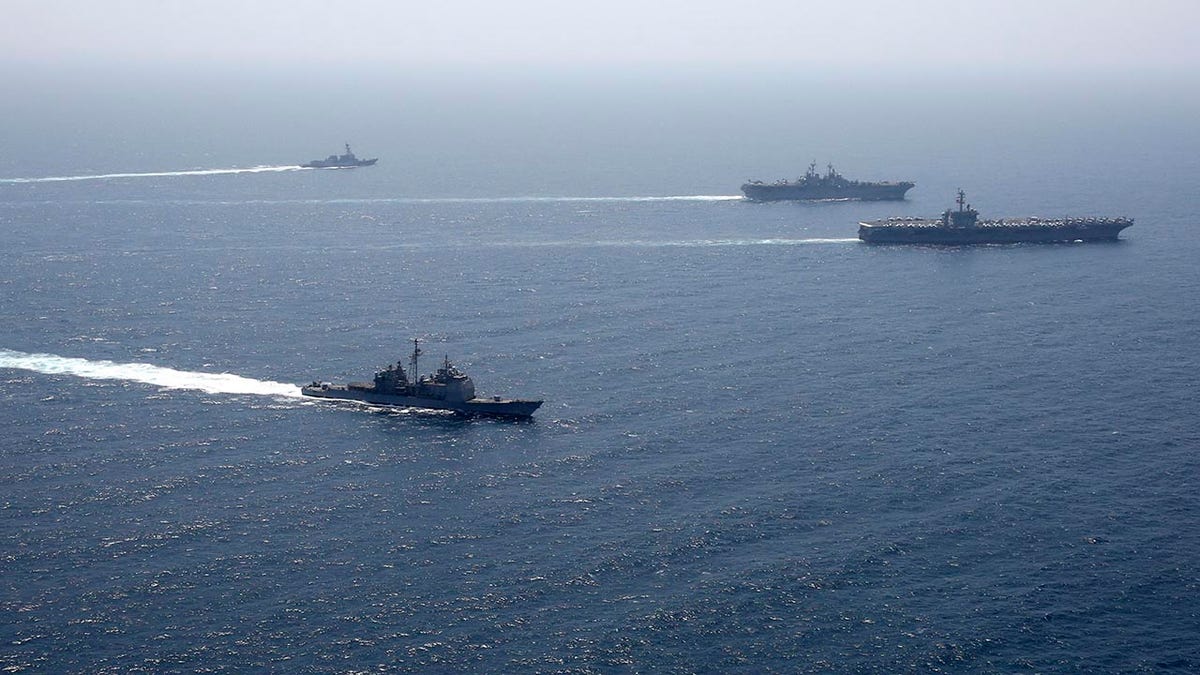
In this photo released by the U.S. Navy, the Abraham Lincoln Carrier Strike Group and Kearsarge Amphibious Ready Group conduct joint operations in the U.S. 5th Fleet area of operations - file photo. (US Navy photo by Mass Communication Specialist Seaman Catie Coyle)
Descending from high altitudes at lethal speeds and often guided by precision sensors, technically improved enemy ballistic missiles can increasingly close in on surface Navy ships, often holding large platforms and even groups of vessels at tremendous risk of destruction.
Many of these threats, to include long-range anti-ship cruise missiles, can travel hundreds of miles to their targets, moving beyond the horizon toward surface ships challenged to detect the approaching weapon with line-of-sight radar systems.
Recognizing the seriousness of these threats, which are quickly increasing in today’s global environment, the Navy is working with industry partners such as Raytheon to integrate an entire family of new radar systems across a wide swath of its surface fleet. The goal is to not only arm surface ships with a new generation of highly-sensitive, discriminating radar technology but succeed in networking them to one another.
NAVY MAY ARM NEW DESTROYER WITH CONVENTIONAL MISSILE ABLE TO HIT ANYWHERE ON EARTH IN AN HOUR
This way, targets from beyond the horizon can be detected by one ship’s radar system, which can then share the “track” information with vulnerable ships miles away. Target data can be passed along, or networked, enabling ship commanders to have more time to identify the best response to the attack. Is a rapid counterattack the best option? Perhaps an interceptor missile might be the better option with which to defend a ship?
The new radars, reported to bring an exponential increase in sensitivity and mission effectiveness to sea-based air and missile defense, are in the process of being built into large portions of the fleet to include emerging new DDG Flight III destroyers, amphibious assault ships and even aircraft carriers. They are called the SPY-6 family of radars, the most powerful of which, the SPY-6 (V)1, is now being engineered into the Navy’s first-of-its kind Flight III Destroyer, the USS Jack Lucas (DDG 125).
The Navy’s Above Water Sensors Program Manager, Capt. Jason Hall explained that the success of the radar systems is inspiring the service to explore new platforms for the technology and pursue a series of weapons and fire control network upgrades moving forward.
NAVY STRATEGY FAST-TRACKS NEW WEAPONS FOR 'OFFENSIVE' ATTACK
“The DDG 125 Jack Lucas sets the technical foundation for the fleet. We plan to leverage this combat system as we look at frigate, amphibs and carriers,” Hall said Jan. 15 at the Surface Naval Association Annual Symposium, Arlington, Va., referring to SPY-6 radar integration.
The SPY-6 family advances the technical curve in a number of tactically significant respects, in part because it can combine ballistic missile defense and air and missile defense into a single integrated system. This synergy gives the system an ability to track and help destroy enemy drones, aircraft, cruise missiles and long-range incoming ballistic missiles.
“A lot of this is in the back end in the digital processing, so it is a huge change. Digital is a big change from the analog of old days, which gives you a lot of the improved discrimination, sensitivity,” Hall said.
NAVY ACCELERATES NEW SHIP RADAR TO SUPPORT EMERGING 'SEA-ATTACK' STRATEGY
Hall said this back-end digital processing and a radar suite controller operate in tandem with a next-generation X-band solid-state radar.
CLICK HERE TO GET THE FOX NEWS APP
“We are building the arrays for this ship. We have run the gamut as to what this radar can do. We have simultaneous weapons support functions. We have electronic protection and environmental protection,” Hall explained.
